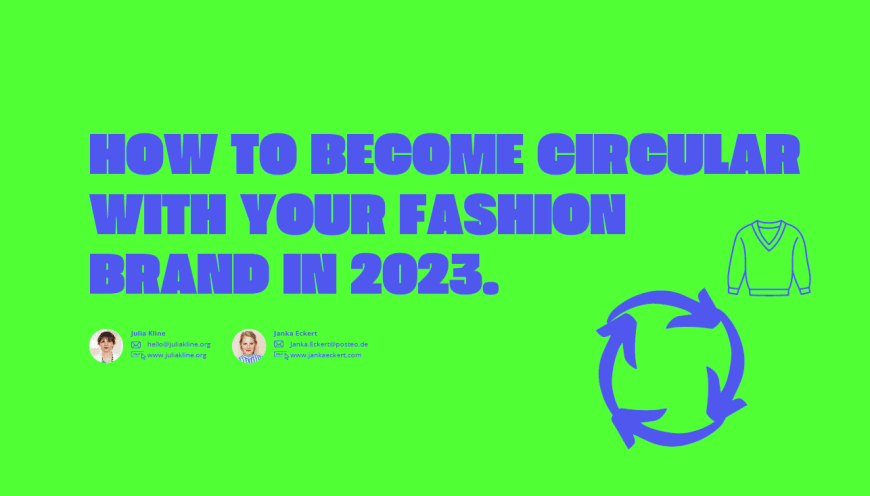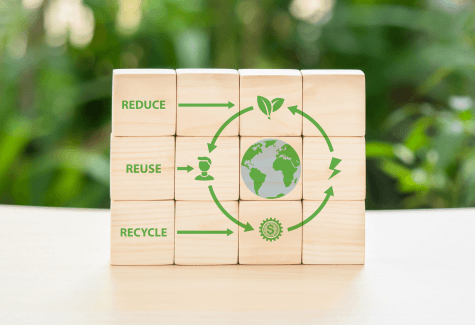In December 2022 Janka Eckert und Julia Kline invited us to a webinar on “How to become circular with your fashion brand in 2023”. Janka and Julia are sustainable fashion consultants and support companies in their transformation in becoming a sustainable player in their industry. Through their expertise, they have developed “The Sustainable Circle”, a 6-month programme which we would like to present to you in this article. Among other things, the two fashion experts revealed the four secrets for a circular fashion label and showed the importance of integrating circular approaches in the fashion sector.
What is the circular economy in the garment industry?
To give us a first feel for the topic, Janka and Julia showed us the current situation of the circular economy in the clothing industry. According to the Ellen MacArthur Foundation, “Still less than 1% of textiles are recycled into new textiles.” and the statement by the Renewal Workshop that “Some 82% of clothing that goes to waste could be cleaned, repaired and reused, or resold” in their 2021 report – Leading Circular Pathways for evolving apparel and textile business from linear to circular, also shows that the apparel industry is not a very sustainable one. The earth’s resources are finite and must be protected to last the coming decades. For this reason, it is important that products and materials used remain in the cycle as long as possible and are returned to the environment at the end of the road. To achieve this in the apparel industry, it is essential that fashion labels adopt a more circular approach. Instead of the linear business model that is currently prevalent in the fashion industry, processes such as repair, reuse and recycling must now be integrated, taking into account the energy required to implement them.
Now, when we go shopping, or see the advertisements of big fashion companies, we are told that fashion companies are already operating sustainably. However, this alleged sustainability often only refers to a few smaller collections and represents a minimal percentage of the company’s entire product range. It is suggested to the customer that the company is already sustainable. However, if you look deeper, you can quickly see that the terms sustainability and circular economy are only used as a marketing tool. Truly sustainable companies also anchor the topic of sustainability in their corporate culture and make it the core of their collections.

What makes a circular fashion label?
In order to be able to operate circularly as a fashion label, it is necessary to understand the full meaning of the term circular economy in fashion. According to Julia and Janka, the circular economy is more than just recycling textiles. It also involves many other aspects, such as the use of biodegradable materials in production or extending the life of garments. These aspects bring new business models for the fashion industry and are the key levers to set up a fashion label in a circular way. Furthermore, they are ways to show customers what to look for in order to become more circular.
The two fashion experts explained that there is a general need to rethink the whole production process, starting with the design phase. Factors such as that garments are repairable and durable, which can massively extend the life cycle of a garment, should be taken into account at the design phase. Considered from an economic point of view, the durable garment can be sold several times and recycled at the end of the life cycle. Thus, the turnover per garment can be almost doubled. Considered from an ecological point of view, the impact on the environment is reduced excessively by increasing the wearing time of a garment, both CO2 emissions and water requirements per garment are reduced.
The environmental impacts of production and sales can be analyzed by means of a life cycle assessment. This assessment takes into account the extraction of raw materials, production and transportation to the customer but according to Julia and Janka, neither the use phase nor the recycling or throwing away of the garment are included in this analysis. However, if we look at the use phase of a garment, this phase has a significant ecological impact. Up to this phase, the emissions of each garment are relatively similar, but in the use phase they differ significantly. The longer a garment is worn, the lower the CO2 equivalents (CO2e), i.e. the smaller the carbon footprint of the garment.

How circular is your fashion label?
To help fashion companies become more circular, Janka and Julia have developed a new tool, the Circularity Scan, for the first phase. Using the scan, companies get a sense how far they have come on their circular journey. The tool is based on the Ellen MacArthur Foundation‘s definition and its three principles:
1. Eliminate waste and pollution
2. Circulate products and materials (at their highest value)
3. Regenerate nature
The scan includes three areas: Business Model, Design and Materials. Each area has five stages into which a company can grade itself. Based on the circularity level of the company, goals and measures can then be derived.
As we already know, it is also important to anchor sustainability in the company. To achieve this, Janka and Julia have developed the Culture Scan. The tool is similar to the Circularity Scan, except that the subject now is the corporate culture of the company. Here, too, the company’s current state is analyzed, goals and measures are developed and summarized in an individual Sustainable Compass, a roadmap for the company.
About the Sustainable Circle
The Sustainable Circle is a 6-month programme in which knowledge about the circular economy in the fashion industry is gathered and active steps are taken on the respective company’s strategy. Community building and exchange of ideas and experiences between the programme participants is another important part of the program. The programme aims to support sustainability managers who want to strengthen their strategy and get more clarity regarding sustainability in the fashion industry.
The first run of the programme will start on 11 April 2023.
For more information, please visit https://www.jankaeckert.com/thesustainablecircle.
Autorin: Josi Quitzke




